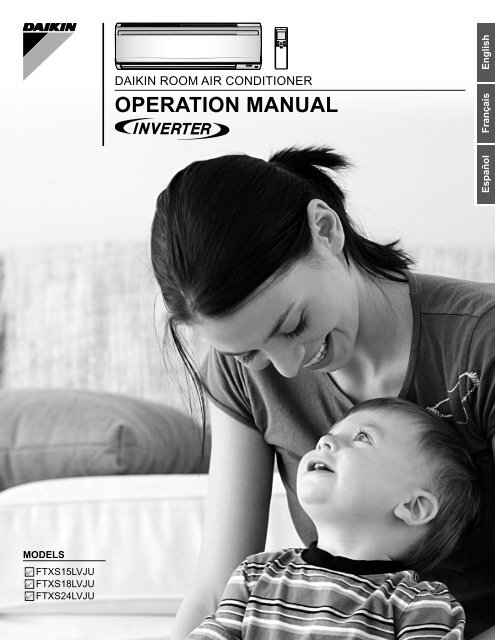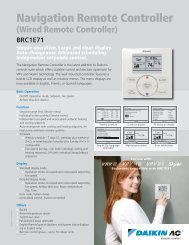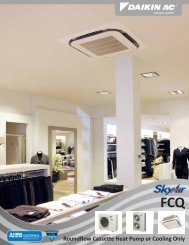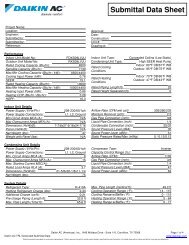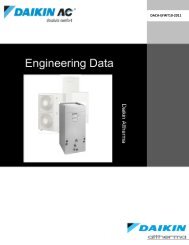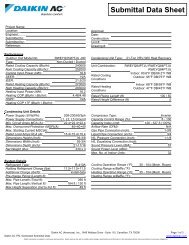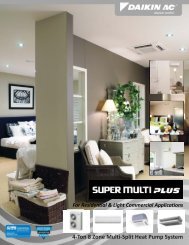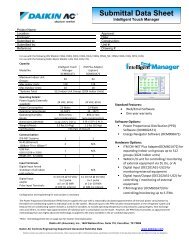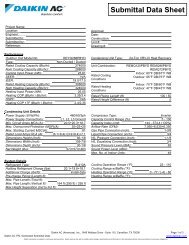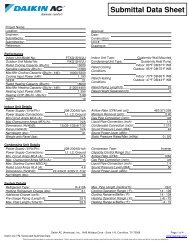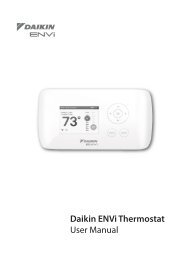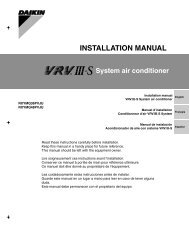OPERATION MANUAL - Daikin AC
OPERATION MANUAL - Daikin AC
OPERATION MANUAL - Daikin AC
- No tags were found...
You also want an ePaper? Increase the reach of your titles
YUMPU automatically turns print PDFs into web optimized ePapers that Google loves.
DAIKIN ROOM AIR CONDITIONER<strong>OPERATION</strong> <strong>MANUAL</strong>EnglishEspañolFrançaisMODELSFTXS15LVJUFTXS18LVJUFTXS24LVJU
FeatureFor your comfort and energysavingINTELLIGENT EYEThe INTELLIGENT EYE sensor detects the human movement ina room. If no one is room for more than 20 minutes, theoperation automatically changes to energy saving operation.Page 15WEEKLY TIMERUp to 4 timer settings can be saved for each day of the weekaccording to your family’s life style. The WEEKLY TIMER allowsyou to set on/off time and the desired temperature. Page 22Other functionsCOMFORT AIRFLOWThe airfl ow direction will be in upward modewhile in COOL operation, in downward modewhile in HEAT operation. This function willprevent cold or warm air from directly blowingon your body. Page 15OUTDOOR UNIT QUIETOUTDOOR UNIT QUIET operationlowers the noise level of the outdoorunit. This function is useful inconsideration of your neighbors.Page 181
Contents• Read before OperationSafety Precautions .............................................. 3Names of Parts .................................................... 5Preparation before Operation .............................. 9English• OperationAUTO · DRY · COOL · HEAT · FANOperation ................................................ 11Adjusting the Airfl ow Directionand Rate ................................................. 13COMFORT AIRFLOW /INTELLIGENT EYE Operation ................ 15POWERFUL Operation ........................... 17OUTDOOR UNIT QUIETOperation ................................................ 18ECONO Operation .................................. 19OFF TIMER Operation ............................ 20ON TIMER Operation ............................. 21WEEKLY TIMER Operation .................... 22• Multi ConnectionNote for Multi System ........................................ 28ECONOThis function enables effi cient operationby limiting the maximum powerconsumption. It is useful when using theair conditioner and other electricaldevices simultaneously. Page 19• CareCare and Cleaning ............................................. 30• TroubleshootingTroubleshooting ................................................. 352
Safety Precautions• Read these safety considerations for operations carefully before installing air conditioning equipment. After completing theinstallation, make sure that the unit operates properly during the startup operation. Instruct the customer on how to operate andmaintain the unit.Inform customers that they should store this operation manual with the installation manual for future reference.Meanings of DANGER, WARNING, CAUTION, and NOTE Symbols:DANGER WARNING CAUTIONIndicates an imminently hazardous situationwhich, if not avoided, will result in death orserious injury.Indicates a potentially hazardous situationwhich, if not avoided, could result in deathor serious injury.Indicates a potentially hazardous situationwhich, if not avoided, may result in minor ormoderate injury. It may also be used to alertagainst unsafe practices.Never do.Be sure to ground the air conditioner.Never touch the air conditioner (including the remotecontroller) with a wet hand.Be sure to follow the instructions.Never allow the air conditioner or remote controller to getwet.DANGER• For refrigerant leakage, consult your dealer.Refrigerant gas is heavier than air and replaces oxygen. A massive leak could lead to oxygen depletion, especially in basements,and an asphyxiation hazard could occur leading to serious injury or death.• Refrigerant gas may produce a toxic gas if it comes in contact with fi re such as from a fan heater, stove or cooking device. Exposureto this gas could cause severe injury or death.• Any abnormalities in the operation of the air conditioner such as smoke or fi re could result in severe injury or death.Turn off the power and contact your dealer immediately for instructions.• Do not install the unit in an area where fl ammable materials are present due to risk of explosion resulting in serious injury or death.• If equipment utilizing a burner is used in the same room as the air conditioner, there is the danger of oxygen defi ciency which couldlead to an asphyxiation hazard resulting in serious injury or death.Be sure to ventilate the room suffi ciently to avoid this hazard.• Safely dispose of the packing materials.Packing materials, such as nails and other metal or wooden parts, may cause stabs or other injuries. Tear apart and throw awayplastic packaging bags so that children will not play with them. Children playing with plastic bags face the danger of death bysuffocation.WARNING• It is not good for health to expose your body to the air fl ow for a long time.• Do not put your finger or other objects into the air outlet or inlet as the fan is rotating at high speed and could cause injury. Alwayskeep small children away from the unit during operation.• Do not attempt to repair, relocate, modify or reinstall the air conditioner by yourself. Incorrect work or modifi cations could causeelectric shocks, fire or other damage.For repairs and reinstallation, consult your <strong>Daikin</strong> dealer for advice and information.• If the air conditioner is not cooling (heating) properly, the refrigerant may be leaking, contact your authorized dealer or qualifiedservice repairman.When making repairs which requires adding refrigerant, consult with your authorized dealer or qualifi ed service repairman.• Do not attempt to install the air conditioner by yourself. Improper installation could result in water leakage, electric shocks or fire. Forinstallation, consult your authorized dealer or a qualifi ed technician.CAUTION• The air conditioner must be grounded. Improper grounding may result in electric shocks. Do not connect the grounding wire to a gaspipe, water pipe, lightning rod, or a telephone ground line. Follow all local and state electrical codes.• Do not use this unit for cooling precision instruments, food, plants, animals or works of art.• Never expose little children, plants or animals directly to the air fl ow.• Do not block air inlets nor outlets. Impaired air fl ow may result in poor performance or equipment problems.• Do not stand, sit, or place objects on the outdoor unit. To avoid injury, do not remove the fan guard.3
EnglishCAUTION• Do not place anything under the indoor or outdoor unit that must be kept away from moisture, such as electrical or electronicequipment. In certain conditions, moisture in the air may condense and drip.• Check the unit stand and fi ttings for damage annually.• Do not touch the air inlet and aluminum fi ns of outdoor unit. It may cause injury and/or damage the heat transfer surface.• This appliance is NOT intended for use by young children or impaired persons without proper supervision.• Young children should be supervised to ensure that they DO NOT play with or near the air fl ow of this appliance.• Do not pull at the conduit or hang anything on it. Otherwise it will cause fi re or electric shock.• Do not touch the heat exchanger fi ns. Improper handling may result in injury.• Do not turn off the power immediately after stopping operation. Always wait at least 5 minutes before turning off the power to avoidwater leakage or other problems.• To avoid personal injury or equipment damage be sure to stop the operation, turn the breaker off or pull out the supply cord beforecleaning or servicing the unit. NOTE: More than one disconnect may be required to shut off all power.• Do not connect the air conditioner to a power supply different from the one specifi ed. It may cause improper operation or fi re.• Depending on the environment, state and local electrical codes, a ground fault circuit interrupter may be required. Impropergrounding or lack of a ground fault circuit interrupter may result in electrical shock, injuries, or death.• It is recommended to install a ground fault circuit interrupter if one is not already available.This helps prevent electrical shocks or fi re.• Arrange the drain hose to ensure smooth drainage. Improper drainage may cause water damage to the building, or its furnishing.• Depending on the usage environment, water may leak from the air conditioner. If this happens, contact your <strong>Daikin</strong> Dealer.• The remote controller should be installed in such away that children cannot play with it.• Do not place objects in direct proximity of the outdoor unit and do not let leaves and other debris accumulate around the unit.Leaves are a hotbed for small animals which can enter the unit. Once in the unit, such animals can cause malfunctions, smoke orfi re when making contact with electrical parts.• Do not operate the air conditioner with wet hands.• Do not wash the indoor unit with excessive water, only use a slightly wet cloth.• Do not place things such as vessels containing water or anything else on top of the unit. Water may penetrate into the unit anddegrade electrical insulations, resulting in an electric shock.Installation site.•Operate the air conditioner in a suffi ciently ventilated area and not surrounded by obstacles. Do not use the airconditioner in the following places.a. Places with a mist of mineral oil, such as cutting oil.b. Locations such as coastal areas where there is a lot of salt in the air.c. Locations such as hot springs where there is a lot of sulfur in the air.d. Locations such as factories where the power voltage varies a lot.e. In cars, boats, and other vehicles.f. Locations such as kitchens where oil may splatter or where there is steam in the air.g. Locations where equipment produces electromagnetic waves.h. Places with an acid or alkaline mist.i. Places where fallen leaves can accumulate or where weeds can grow.Consider the nuisance of noise to your neighbors.•Pay Attention to Operating Sound. Be sure to use the following places:a. Places that can sufficiently withstand the weight of the air conditioner yet can suppress the operating sound and vibration of the airconditioner.b. Places where warm air from the air outlet of the outside unit or the operating sound of the outside unit does not annoy neighbors.Make sure that there are no obstacles close to the outside unit. Obstacles close to the outside unit may drop the performance of theoutside unit or increase the operating sound of the outside unit.Consult your dealer if the air conditioner in operation generates unusual noise.Electrical work.• For power supply, be sure to use a separate power circuit dedicated to the air conditioner.System relocation.•Relocating the air conditioner requires specialized knowledge and skills. Please consult the dealer if relocation isnecessary for moving or remodeling.4
Names of PartsIndoor UnitFront panelAir inletPanel tabModel nameplateINTELLIGENT EYEsensor• It detects the movements ofpeople and automaticallyswitches between normaloperation and energy savingoperation. Page 15Air outletFins (vertical blades)• The fi ns are inside of the airoutlet. Page 13Louvers(horizontal blades) Page 13Room temperaturesensor• It detects the air temperaturearound the unit.Signal receiver• It receives signals from the remotecontroller.• When the unit receives a signal, youwill hear a beep sound.CaseOperation startSetting changedOperation stopSound typebeep-beepbeeplong beepDisplay<strong>OPERATION</strong> lamp (green)TIMER lamp (yellow)Page 20,21INTELLIGENT EYE lamp(green) Page 15,16Indoor unit ON/OFF switch• Press this switch once to start operation.Press once again to stop it.• The operation mode refer to the following table.Mode Temperature setting Airfl ow rateAUTO 77°F (25°C) AUTO• This switch is useful when the remote controller is missing.5
English• Open the front panelAir filterOutdoor Unit• Appearance of the outdoor unit may differ from some models.Air inlet(back and side)Titanium apatitephotocatalyticair-purifying filterOutdoor temperaturesensor (back)Drain hoseGround terminal• Inside this cover.Air outletModel name plateRefrigerant piping andinter-unit wiring6
Names of PartsRemote ControllerSignal transmitterReceiver• To use the remote controller, aim thetransmitter at the indoor unit. If thereis anything to block signals betweenthe unit and the remote controller,such as a curtain, the unit will notoperate.• Do not drop the remote controller. Donot get it wet.• The maximum distance forcommunication is approximately 23ft(7m).Display (LCD)• Displays the current settings.(In this illustration, each section isshown with all its displays on for thepurpose of explanation.)TEMPERATUREadjustment buttons• Changes the temperature setting.Page 12FAN setting button• Selects the airfl ow rate setting.Page 14ON/OFF button• Press this button once to startoperation.Press once again to stop it. Page 11POWERFUL button• POWERFUL operation. Page 17Front cover• Open the front cover. Page 87
English• Open the front coverMODE selector button• Selects the operation mode.(AUTO/DRY/COOL/HEAT/FAN) Page 11ECONO button• ECONO operation. Page 19SWING button• Adjusting the airfl ow direction.Page 13QUIET button• OUTDOOR UNIT QUIEToperation. Page 18COMFORT/SENSORbutton• COMFORT AIRFLOW andINTELLIGENT EYE operation.Page 15,16OFF TIMER buttonPage 20TIMER CANCELbutton• Cancels the timer setting.Page 20,21• It cannot be used for theWEEKLY TIMER operation.: WEEKLY button: PROGRAM button: COPY button: B<strong>AC</strong>K button: NEXT button• WEEKLY TIMER operation.Page 22SELECT button• Changes the ON/OFF TIMERand WEEKLY TIMER settings.Page 20,21,22ON TIMER buttonPage 21CLOCK button Page 108
Preparation before Operation12Position + and– correctly!3• To set the batteries1. Slide the front cover to take it off.2. Set two dry batteries AAA.LR03 (alkaline).3. Set the front cover as before.• To fix the remote controller holder on the wallScrewsRemote controllerRemotecontroller holder1. Choose a place from where the signals reachthe unit.2. Fix the holder to a wall, a pillar, etc. with thescrews supplied with the holder.3. Place the remote controller in the remotecontroller holder.• Celsius/Fahrenheit display switch9NOTE• The Celsius or Fahrenheit display is selectable with the following buttons.Press and simultaneously for5 seconds.• The temperature will be displayed in Fahrenheit if it is presently displayed in Celsius,and vice versa.• Notes on batteries• When replacing the batteries, use batteries of the same type, and replace both batteries at the same time.• When the system is not used for a long time, take the batteries out.• The batteries will last for approximately 1 year. If the remote controller display begins to fade and the degradation of reception performanceoccurs within a year, however, replace both batteries with new, size AAA.LR03 (alkaline).• The attached batteries are provided for the initial use of the system.The usable period of the batteries may be short depending on the manufactured date of the air conditioner.• Notes on remote controller• Never expose the remote controller to direct sunlight.• Dust on the signal transmitter or receiver will reduce the sensitivity. Wipe off dust with a soft cloth.• Signal communication may be disabled if an electronic-starter-type fl uorescent lamp (such as inverter-type lamps) is in the room. Consult theshop if that is the case.• If the remote controller signals happen to operate another appliance, move that appliance somewhere else, or consult the service shop.• Celsius/Fahrenheit display change function of remote controller• The set temperature may increase when the display is changed to Celsius from Fahrenheit, because a fraction of 0.5°C is rounded up.• Example: A set temperature of 65°F (equivalent to 18.5°C) will be converted into 19°C.When the display is changed to Fahrenheit again, the set temperature will be converted into 66°F (equivalent to 19°C) instead of theoriginal set temperature (65°F) but a set temperature of 66°F (equivalent to 19°C) will be converted into 19°C with no temperature change.• A reception sound will go off for the transmission of set temperature to the indoor unit at the time of setting the Celsius/Fahrenheit display change function.
English• Turn the breaker on• After the power is turned on, the louvers of the indoor unit open and close once to setthe reference position.• To set the clock1. Press .“ ” is displayed.“ ” and “ ” blink.2. Press to set the current day of the week.3. Press .“ ” blinks.4. Press to set the clock to the present time.• Holding down or rapidly increases or decreases the time display.5. Press .• Point the remote controller at the indoor unit when pressing the buttons.“ ” blinks.10
AUTO · DRY · COOL · HEAT ·FAN OperationThe air conditioner operates with the operation mode of your choice.From the next time on, the air conditioner will operate with the same operation mode.• To start operation1. Press and select an operation mode.• Each pressing of the button advances the mode setting in sequence.AUTO DRY COOL HEAT FAN2. Press .• “ ” is displayed on the LCD.• The <strong>OPERATION</strong> lamp lights green.Display• To stop operationPress again.• “ ” is no longer displayed on the LCD.• The <strong>OPERATION</strong> lamp goes off.NOTEMODEHEATCOOLDRYAUTOFANNotes on each operation mode• Since this air conditioner heats the room by taking heat from outdoor air to indoors, the heating capacity becomes smaller in lower outdoortemperatures. If the heating effect is insufficient, it is recommended to use another heating appliance in combination with the air conditioner.• The heat pump system heats the room by circulating hot air around all parts of the room. After the start of HEAT operation, it takessome time before the room gets warmer.• In HEAT operation, frost may occur on the outdoor unit and lower the heating capacity. In that case, the system switches intodefrosting operation to take away the frost.• During defrosting operation, hot air does not fl ow out of indoor unit.• This air conditioner cools the room by releasing the heat in the room outside. Therefore, the cooling performance of the airconditioner may be degraded if the outdoor temperature is high.• The computer chip works to rid the room of humidity while maintaining the temperature as much as possible. It automaticallycontrols temperature and airfl ow rate, so manual adjustment of these functions is unavailable.• In AUTO operation, the system selects an appropriate operation mode (COOL or HEAT) based on the room and outsidetemperatures and starts the operation.• The system automatically reselects setting at a regular interval to bring the room temperature to user-setting level.• This mode is valid for fan only.11
English• To change the temperature settingPress or .• The displayed items on the LCD will change whenever either one of the buttons ispressed.COOL operation HEAT operation AUTO operation DRY or FAN operation64-90°F(18-32°C)50-86°F(10-30°C)64-86°F(18-30°C)Press to raise the temperature and press to lower thetemperature.The temperature setting isnot variable.• Operating conditions• Recommended temperature setting• For cooling: 78-82°F (26-28°C)• For heating: 68-75°F (20-24°C)• Tips for saving energy• Be careful not to cool (heat) the room too much.Keeping the temperature setting at a moderate level helps save energy.• Cover windows with a blind or a curtain.Blocking sunlight and air from outdoors increases the cooling (heating) effect.• Clogged air fi lters cause ineffi cient operation and waste energy. Clean them once in about every 2 weeks. Page 32• Notes on the operating conditions• The air conditioner always consumes a small amount of electricity even while it is not operating.• If you are not going to use the air conditioner for a long period, for example in spring or autumn, turn the breaker off.• Use the air conditioner in the following conditions.MODE Operating conditions If operation is continued out of this rangeCOOLHEATDRYOutdoor temperature : 50-115°F (10-46°C)Indoor temperature : 64-90°F (18-32°C)Indoor humidity : 80% max.Outdoor temperature : 5-75°F (–15-24°C)Indoor temperature : 50-86°F (10-30°C)Outdoor temperature : 50-115°F (10-46°C)Indoor temperature : 64-90°F (18-32°C)Indoor humidity : 80% max.• A safety device may work to stop the operation.(In multi system, it may work to stop the operation of the outdoor unit only.)• Condensation may occur on the indoor unit and drip.• A safety device may work to stop the operation.• A safety device may work to stop the operation.• Condensation may occur on the indoor unit and drip.• Operation outside this humidity or temperature range may cause a safety device to disable the system.12
Adjusting the Airflow Directionand RateYou can adjust the airfl ow direction to increase your comfort.• To start auto swingUpper and lower airflow directionPress .• “ ” is displayed on the LCD.• The louvers (horizontal blades) will begin to swing.Right and left airflow directionPress .• “ ” is displayed on the LCD.• The fi ns (vertical blades) will begin to swing.The 3-D airflow directionPress and .• “ ” and “ ” are displayed on the LCD.• The louvers and fi ns move in turn.• To cancel 3-D airfl ow, press either or again.The louvers or fi ns will stop moving.• To set the louvers or fins at desired position• This function is effective while louvers or fi ns are in auto swing mode.Press and when the louvers orfins have reached the desired position.• In the 3-D airfl ow, the louvers and fi ns move in turn.• “ ” or “ ” is no longer displayed on the LCD.13
English• To adjust the airflow rate settingPress .• Each pressing of advances the airfl ow rate setting in sequence.Auto Indoor unit quiet Low Middle lowHighMiddle highMiddle• When the airfl ow is set to “ ”, indoor unit quiet operation will start and the noisefrom the unit will become quieter.• In indoor unit quiet operation, the airfl ow rate is set to a weak level.• In DRY operation, the airfl ow rate setting is not variable.NOTE• Notes on the angles of the louvers• The louvers swinging range depends on the operation. (See the fi gure.)COOL and DRY operation HEAT operation FAN operationStop operationCOMFORT AIRFLOW10°15°Upper limit50°Lower limitStop operation30°Upper limit 70°Lower limit75°COMFORT AIRFLOW15°Upper limit70°Lower limitStop operation• Note on 3-D airflow• Using 3-D airfl ow circulates cold air, which tends to collected at the bottom of the room, and hot air, which tends to collect near the ceiling,throughout the room, preventing areas of cold and hot developing.• Note on airflow rate setting• At smaller airfl ow rates, the cooling (heating) effect is also smaller.CAUTION• Always use a remote controller to adjust the angles of the louvers and fi ns. If you attempt to move the louvers and fi ns forcibly with hand when theyare swinging, the mechanism may be broken.• Always use a remote controller to adjust the fi ns angles. Inside the air outlet, a fan is rotating at a high speed.14
COMFORT AIRFLOW /INTELLIGENT EYE Operation• COMFORT AIRFLOW operationThe flow of air will be in the upward direction while in COOL operation and in the downward direction while inHEAT operation, which will provide a comfortable wind that will not come in direct contact with people.COOL operationHEAT operation• INTELLIGENT EYE operation“INTELLIGENT EYE” is the infrared sensor which detects the human movement.If no one is in the room for more than 20 minutes, the operation automatically changes to energy savingoperation.[Example]When someone is inthe room•Normal operation• The air conditioner is innormal operation while thesensor is detecting themovement of people.When no one is in theroom•20 minutes after, startenergy savingoperation.• The set temperature isshifted in ±3.6°F (±2°C)steps.Someone is back in theroom•Back to normaloperation.• The air conditioner willreturn to normal operationwhen the sensor detects themovement of people again.INTELLIGENT EYE operation is useful for energy saving• Energy saving operation• If no presence detected in the room for 20 minutes, the energy saving operation will start.• This operation changes the temperature –3.6°F (–2°C) in HEAT / +3.6°F (+2°C) in COOL / +3.6°F (+2°C) in DRY operation from set temperature.When the room temperature exceeds 86°F (30°C), the operation changes the temperature +1.8°F (+1°C) in COOL / +1.8°F (+1°C) in DRYoperation from set temperature.• This operation decreases the airfl ow rate slightly in FAN mode only.15• Combination COMFORT AIRFLOW and INTELLIGENT EYE operationThe air conditioner can go into operation with the COMFORT AIRFLOW and INTELLIGENT EYE functionscombined.
English• To start operationPressand select the desired mode.• Each time the is pressed a different setting option is displayed on the LCD.• The INTELLIGENT EYE lamp lights green.Display• By selecting “ ” from the following icons, the air conditioner will be in COMFORTAIRFLOW operation combined with INTELLIGENT EYE operation.COMFORTAIRFLOWINTELLIGENTEYECombinationblankNo SettingNOTE• When the louvers (horizontal blades) are swinging, the operating as above will stopmovement of them.• The lamp will be lit while human movements are detected.• To cancel operationPress• The INTELLIGENT EYE lamp goes off.• Notes on COMFORT AIRFLOW operation• The louver position will change, preventing air from blowing directly on the occupants of the room.and select “blank” on the LCD.• POWERFUL operation and COMFORT AIRFLOW operation cannot be used at the same time.Priority is given to the function of whichever button is pressed last.• The airfl ow rate will be set to AUTO. If the upper and lower airfl ow direction is selected, the COMFORT AIRFLOW function will be canceled.• Notes on INTELLIGENT EYE operation• Application range is as follows.Vertical angle 90°(Side view)23ft (7m)90°Horizontalangle 110°(Top view)55°55°23ft(7m)• Sensor may not detect moving objects further than 23ft (7m) away. (Check the application range)• Sensor detection sensitivity changes according to indoor unit location, the speed of passersby, temperature range, etc.• The sensor also mistakenly detects pets, sunlight, fl uttering curtains and light refl ected off of mirrors as passersby.• INTELLIGENT EYE operation will not go on during POWERFUL operation.• NIGHT SET mode Page 20 will not go on during use of INTELLIGENT EYE operation.• Notes on combination of COMFORT AIRFLOW operation and INTELLIGENT EYE operation• The airflow rate will be set to AUTO. If the upper and lower airfl ow direction is selected, the COMFORT AIRFLOW operation will be canceled.Priority is given to the function of whichever button is pressed last.CAUTION• Do not place large objects near the sensor.Also keep heating units or humidifi ers outside the sensor’s detection area. This sensor can detect undesirable objects.• Do not hit or violently push the INTELLIGENT EYE sensor. This can lead to damage and malfunction.16
POWERFUL OperationPOWERFUL operation quickly maximizes the cooling (heating) effect in anyoperation mode. You can get the maximum capacity.• To start POWERFUL operationPressduring operation.• POWERFUL operation ends in 20 minutes. Then the system automatically operatesagain with the previous settings which were used before POWERFUL operation.• “ ” is displayed on the LCD.• To cancel POWERFUL operationPressagain.[Example]• “ ” is no longer displayed on the LCD.•Normal operation• When you want to get thecooling effect quickly, startthe POWERFUL operation.•POWERFUL operation• POWERFUL operation willwork for 20 minutes.•Back to normaloperationNOTE• Notes on POWERFUL operation• When using POWERFUL operation, there are some functions which are not available.17• POWERFUL operation cannot be used together with ECONO, COMFORT AIRFLOW or OUTDOOR UNIT QUIET operation.Priority is given to the function of whichever button is pressed last.• POWERFUL operation can only be set when the unit is running. Pressing causes the settings to be canceled, and “ ” is no longerdisplayed on the LCD.• POWERFUL operation will not increase the capacity of the air conditioner if the air conditioner is already in operation with its maximum capacitydemonstrated.• In COOL, HEAT and AUTO operationTo maximize the cooling (heating) effect, the capacity of outdoor unit is increased and the airfl ow rate is fi xed to the maximum setting.The temperature and airfl ow settings are not variable.• In DRY operationThe temperature setting is lowered by 4.5°F (2.5°C) and the airfl ow rate is slightly increased.• In FAN operationThe airflow rate is fixed to the maximum setting.
OUTDOOR UNIT QUIETOperationEnglishOUTDOOR UNIT QUIET operation lowers the noise level of the outdoor unit bychanging the frequency and fan speed on the outdoor unit. This function isconvenient during the night.• To start OUTDOOR UNIT QUIET operationPress .• “ ” is displayed on the LCD.• To cancel OUTDOOR UNIT QUIET operationPressagain.• “ ” is no longer displayed on the LCD.[Example] Using the OUTDOOR UNIT QUIET operation during the night.• The noise level of the outdoor unit will be lower.This is convenient in consideration of your neighbors.NOTE• Notes on OUTDOOR UNIT QUIET operation• If using a multi system, the OUTDOOR UNIT QUIET operation will work only when this function is set on all operated indoor units. However, ifusing priority room setting, refer to “Note for multi system”. Page 28• This function is available in COOL, HEAT, and AUTO operation.This is not available in FAN and DRY operation.• POWERFUL operation and OUTDOOR UNIT QUIET operation cannot be used at the same time.Priority is given to the function of whichever button is pressed last.• Even the operation is stopped using the remote controller or the indoor unit ON/OFF switch when using OUTDOOR UNIT QUIET operation, “ ”will remain on the remote controller display.• OUTDOOR UNIT QUIET operation will drop neither the frequency nor fan speed if they have been already dropped low enough.18
ECONO OperationECONO operation is a function which enables effi cient operation by limiting themaximum power consumption value.This function is useful for cases in which attention should be paid to ensure acircuit breaker will not trip when the product runs alongside other appliances.• To start ECONO operationPressduring operation.• “ ” is displayed on the LCD.• To cancel ECONO operationPressagain.• “ ” is no longer displayed on the LCD.[Example]Normal operationECONO operation• In case the air conditioner and otherappliances which require high powerconsumption are used at same time, a circuitbreaker may trip if the air conditioner operatewith its maximum capacity.• The maximum power consumption of the airconditioner is limited by using ECONO operation.The circuit breaker is unlikely to trip even if theair conditioner and other appliances are used atsame time.Running current andpower consumptionECONOoperationNormaloperationMaximum duringnormal operationMaximum duringECONO operation• This diagram is a representation for illustrativepurposes only.The maximum running current and powerconsumption of the air conditioner in ECONOoperation vary with the connecting outdoorunit.NOTE• Notes on ECONO operation19TimeFrom start up until set temperature is reached• ECONO operation can only be set when the unit is running. Pressing causes the settings to be canceled, and “ ” is no longer displayedon the LCD.• ECONO operation functions in AUTO, COOL, DRY, and HEAT operation.• POWERFUL and ECONO operation cannot be used at the same time.Priority is given to the function of whichever button is pressed last.• If the level of power consumption is already low, ECONO operation will not drop the power consumption.
OFF TIMER OperationEnglishTimer functions are useful for automatically switching the air conditioner on or offat night or in the morning. You can also use OFF TIMER and ON TIMER incombination.• To use OFF TIMER operation• Check that the clock is correct.If not, set the clock to the present time. Page 101. Press .“ ” is displayed on the LCD.“ ” blinks.• “ ” is no longer displayed on the LCD.2. Press until the time setting reaches thepoint you like.• Each pressing of either button increases or decreases the time setting by 10 minutes.Holding down either button changes the time setting rapidly.3. Press again.• “ ” and setting time are displayed on the LCD.• The TIMER lamp lights yellow.DisplayNOTE• Notes on TIMER operation• When TIMER is set, the present time is not displayed.• To cancel OFF TIMER operationPress .• “ ” and setting time are no longer displayed on the LCD.• “ ” and day of the week are displayed on the LCD.• The TIMER lamp goes off.• Once you set ON/OFF TIMER, the time setting is kept in the memory. The memory is canceled when remote controller batteries are replaced.• When operating the unit via the ON/OFF TIMER, the actual length of operation may vary from the time entered by the user. (Maximumapproximately 10 minutes)• NIGHT SET mode• When the OFF TIMER is set, the air conditioner automatically adjusts the temperature setting (0.9°F (0.5°C) up in COOL, 3.6°F (2.0°C) down inHEAT) to prevent excessive cooling (heating) for your pleasant sleep.20
ON TIMER Operation• To use ON TIMER operation• Check that the clock is correct.If not, set the clock to the present time. Page 101. Press .“ ” is displayed on the LCD.“ ” blinks.• “ ” and day of the week are no longer displayed on the LCD.2. Press until the time setting reaches thepoint you like.• Each pressing of either button increases or decreases the time setting by 10 minutes.Holding down either button changes the setting rapidly.3. Press again.• “ ” and setting time are displayed on the LCD.• The TIMER lamp lights yellow.Display• To cancel ON TIMER operationPress .• “ ” and setting time are no longer displayed on the LCD.• “ ” and day of the week are displayed on the LCD.• The TIMER lamp goes off.• To combine ON TIMER and OFF TIMER• A sample setting for combining the 2 timers is shown below.(Example)Present time: 23:00 (The unit operating)OFF TIMER at 0:00CombinedON TIMER at 14:00NOTE• In the following cases, set the timer again.• After a breaker has turned off.• After a power failure.• After replacing batteries in the remote controller.21
WEEKLY TIMER OperationEnglishUp to 4 timer settings can be saved for each day of the week. It is convenient if the WEEKLY TIMER is setaccording to the family’s life style.• Using in these cases of WEEKLY TIMERExample: The same timer settings are made for the week from Monday through Friday while different timer settings are madefor the weekend.[Monday] Make timer settings up to programs 1-4. Page 23Program 1 Program 2 Program 3 Program 4ON OFF ON OFF77°F (25°C) 81°F (27°C)6:00 8:30 17:30 22:00ON OFFON OFF[Tuesday]to[Friday][Saturday]Use the copy mode to make settings for Tuesday to Friday, because these settings are the same as thosefor Monday. Page 25Program 1 Program 2 Program 3 Program 4ON OFF ON OFFNo timer settings77°F (25°C) 81°F (27°C)6:00 8:30 17:30 22:00[Sunday] Make timer settings up to programs 1-4. Page 23Program 1 Program 2 Program 3 Program 4ON OFF OFF ON77°F (25°C)81°F (27°C) 81°F (27°C)8:00 10:00 19:00 21:00ONOFFOFFON• Up to 4 reservations per day and 28 reservations per week can be set in the WEEKLY TIMER. The effective use of the copymode ensures ease of making reservations.• The use of ON-ON-ON-ON settings, for example, makes it possible to schedule operating mode and set temperature changes.Furthermore, by using OFF-OFF-OFF-OFF settings, only the turn off time of each day can be set. This will turn off the airconditioner automatically if the user forgets to turn it off.22
WEEKLY TIMER Operation• To use WEEKLY TIMER operationSetting mode• Make sure the day of the week and time are set. If not, set the day of the week and time.Page 10Program 1 Program 2 Program 3 Program 4ON OFF ON OFF[Monday] 77°F (25°C) 81°F (27°C)6:00 8:30 17:30 22:00Setting DisplaysDay and number settings ON/OFF settings Time settings Temperature settings1. Press .• The day of the week and the reservation number of the current day will be displayed.• 1 to 4 settings can be made per day.2. Press to select the desired day of theweek and reservation number.• Pressing changes the reservation number and the day of the week.3. Press .• The day of the week and reservation number will be set.• “ ” and “ ” blink.4. Press to select the desired mode.• Pressing changes “ ” or “ ” setting in sequence.ON TIMER OFF TIMER blank• In case the reservation has already been set, selecting “blank” deletes thereservation.• Go to STEP 9 if “blank” is selected.5. Press .• The ON/OFF TIMER mode will be set.• “ ” and the time blink.23
English6. Press to select the desired time.• The time can be set between 0:00 and 23:50 in 10 minute intervals.• To return to the ON/OFF TIMER mode setting, press .• Go to STEP 9 when setting the OFF TIMER.7. Press .• The time will be set.• “ ” and the temperature blink.8. Press to select the desired temperature.• The temperature can be set between 50°F (10°C) and 90°F (32°C).Cooling: The unit operates at 64°F (18°C) even if it is set at 50 (10) to 63°F (17°C).Heating: The unit operates at 86°F (30°C) even if it is set at 87 (31) to 90°F (32°C).• To return to the time setting, press .• The set temperature is only displayed when the mode setting is on.9. Press .• The temperature will be set and go to the next reservation setting.• To continue further settings, repeat the procedure from STEP 4.10. Press to complete the setting.• Be sure to direct the remote controller toward the indoor unit and check for a receivingtone and fl ashing the <strong>OPERATION</strong> lamp.• “ ” is displayed on the LCD and WEEKLY TIMER operation is activated.• The TIMER lamp lights yellow.NOTEDisplay• Notes on WEEKLY TIMER operation• Do not forget to set the clock on the remote controller fi rst. Page 10• A reservation made once can be easily copied and the same settings used for anotherday of the week. Refer to Copy mode . Page 25• The day of the week, ON/OFF TIMER mode, time and set temperature (only for ON TIMER mode) can be set with WEEKLY TIMER.Other settings for ON TIMER are based on the settings just before the operation.• Both WEEKLY TIMER and ON/OFF TIMER operation cannot be used at the same time. The ON/OFF TIMER operation has priority if it is setwhile WEEKLY TIMER is still active. The WEEKLY TIMER will go into standby state, and “ ” will be no longer displayed on the LCD.When ON/OFF TIMER is up, the WEEKLY TIMER will automatically become active.• Only the time and set temperature with the WEEKLY TIMER are sent with the . Set the WEEKLY TIMER only after setting the operationmode, the airflow rate and the airfl ow direction ahead of time.• Shutting the breaker off, power failure, and other similar events will render operation of the indoor unit’s internal clock inaccurate. Reset theclock. Page 10• The can be used only for the time and temperature settings. It cannot be used to go back to the reservation number.24
WEEKLY TIMER OperationCopy mode• A reservation made once can be copied to another day of the week. The whole reservationof the selected day of the week will be copied.[Monday]COPY[Tuesday]to[Friday]Setting DisplaysProgram 1 Program 2 Program 3 Program 4ON OFF ON OFF77°F (25°C) 81°F (27°C)6:00 8:30 17:30 22:00Program 1 Program 2 Program 3 Program 4ON OFF ON OFF77°F (25°C) 81°F (27°C)6:00 8:30 17:30 22:00Confi rmation display Copy display Paste display Normal displayNOTE251. Press .2. Press to confirm the day of the week to becopied.Press3. .• The whole reservation of the selected day of the week will be copied.4. Press to select the destination day of the week.5. Press .• The reservation will be copied to the selected day of the week. The whole reservationof the selected day of the week will be copied.• To continue copying the settings to other days of the week, repeat STEP 4 andSTEP 5.6. Press to complete the setting.• “ ” is displayed on the LCD and WEEKLY TIMER operation is activated.• Note on COPY MODE• The entire reservation of the source day of the week is copied in the copy mode.In the case of making a reservation change for any day of the week individually after copying the content of weekly reservations, pressand change the settings in the steps of Setting mode . Page 23
English• Confirming a reservation• The reservation can be confi rmed.Setting DisplaysNormal displayConfi rmation display1. Press .• The day of the week and the reservation number of current day will be displayed.2. Press to select the day of the week andthe reservation number to be confirmed.• Pressing displays the reservation details.• To change the confi rmed reserved settings, select the reservation number and press.The mode is switched to setting mode. Go to Setting mode STEP 4. Page 233. Press to exit confirming mode.• “ ” is displayed on the LCD and WEEKLY TIMER operation is activated.• The TIMER lamp lights yellow.Display• To deactivate WEEKLY TIMER operationPress while “ ” is displayed onthe LCD.• “ ” will be no longer displayed on the LCD.• The TIMER lamp goes off.• To reactivate the WEEKLY TIMER operation, press again.• If a reservation deactivated with is activated once again, the last reservationmode will be used.26
WEEKLY TIMER Operation• To delete reservationsThe individual reservation1. Press .• The day of the week and the reservation number will be displayed.2. Press to select the day of the week andthe reservation number to be deleted.Press3. .• “ ” and “ ” or “ ” blink.4. Press and select “ blank ”.• Pressing changes ON/OFF TIMER mode.• The reservation will be no setting with selecting “blank”.ON TIMER OFF TIMER blank5. Press .• The selected reservation will be deleted.6. Press .• If there are still other reservations, WEEKLY TIMER operation will be activated.The reservations for each day of the week• This function can be used for deleting reservations for each day of the week.• It can be used while confi rming or setting reservations.1. Press to select the day of the week to bedeleted.2. Hold for 5 seconds.• The reservation of the selected day of the week will be deleted.All reservations27Holdfor 5 seconds while normal display.• Be sure to direct the remote controller toward the indoor unit and check for a receiving tone.• This operation is not effective on the setting display of WEEKLY TIMER.• All reservations will be deleted.
Note for Multi SystemEnglishMulti system has one outdoor unit connected to multiple indoor units.• Selecting the operation modeWith the priority room setting present butinactive or not present.When more than one indoor unit is operating, priority is given to thefi rst unit that was turned on.In this case, set the units that are turned on later to the same operationmode as the fi rst unit.Otherwise, they will enter the standby state, and the <strong>OPERATION</strong>lamp will fl ash: this does not indicate malfunction.A roomC roomB roomD roomNOTE• Notes on operation mode for multi system• COOL, DRY and FAN operation may be used at the same time.• AUTO operation automatically selects COOL operation or HEAT operation based on the room temperature.Therefore, AUTO operation is available when selecting the same operation mode as that of the room with the fi rst unit to be turned on.CAUTION• Normally, the operation mode in the room where the unit is fi rst run is given priority, but the following situations are exceptions, so please keep thisin mind.If the operation mode of the first room is FAN operation, then using HEAT operation in any room after this will give priority to HEAT operation. Inthis situation, the air conditioner running in FAN operation will go on standby, and the <strong>OPERATION</strong> lamp will fl ash.With the priority room setting active.Refer to “Priority room setting” on the next page.• NIGHT QUIET mode (Available only for COOL operation)NIGHT QUIET mode requires initial programming during installation. Please consult your retailer or dealer for assistance.NIGHT QUIET mode reduces the operation noise of the outdoor unit during the nighttime hours to prevent annoyance toneighbors.• The NIGHT QUIET mode is activated when the temperature drops 10.8°F (6°C) or more below the highest temperature recorded that day.Therefore, when the temperature difference is less than 7.2°F (4°C), this function will not be activated.• NIGHT QUIET mode reduces slightly the cooling effi ciency of the unit.• OUTDOOR UNIT QUIET operationRefer to “OUTDOOR UNIT QUIET operation”. Page 18With the priority room setting present but inactive or not present.When using the OUTDOOR UNIT QUIET operation feature with the Multi system, set all indoor units to OUTDOOR UNITQUIET operation using their remote controllers.When clearing OUTDOOR UNIT QUIET operation, clear one of the operating indoor units using their remote controller.However OUTDOOR UNIT QUIET operation display remains on the remote controller for other rooms.We recommend you release all rooms using their remote controllers.With the priority room setting active.Refer to “Priority room setting” on the next page.Outdoor unit28
Note for Multi System• COOL / HEAT mode lockThe COOL / HEAT mode lock requires initial programming during installation. Please consult your authorized dealer forassistance. The COOL / HEAT mode lock sets the unit forcibly to either COOL or HEAT operation. This function is convenientwhen you wish to set all indoor units connected to the multi system to the same operation mode.• Priority room settingThe priority room setting requires initial programming during installation. Please consult your authorized dealer for assistance.The room designated as the priority room takes priority in the following situations.Operation mode priority• As the operation mode of the priority room takes precedence, the user can select a different operation mode from otherrooms.[Example]• Room A is the priority room in the examples.When COOL operation is selected in room A while operating the following modes in room B, C and D :Operation mode in room B, C and DCOOL or DRY or FANHEATAUTOStatus of room B, C and D when the unit in room A is in COOL operationCurrent operation mode maintainedThe unit enters standby mode. Operation resumes when the room A unit stops operating.If the unit is set to COOL operation, it continues. If the unit is set to HEAT operation, it enters standbymode. Operation resumes when the room A unit stops operating.Priority when POWERFUL operation is used[Example]• Room A is the priority room in the examples.The indoor units in rooms A, B, C and D are all operating. If the unit in room A enters POWERFUL operation, operationcapacity will be concentrated in room A. In such a case, the cooling (heating) effi ciency of the units in room B, C and D maybe slightly reduced.Priority when using OUTDOOR UNIT QUIET operation[Example]• Room A is the priority room in the examples.Just by setting the unit in room A to QUIET operation, the air conditioner starts OUTDOOR UNIT QUIET operation.You don’t have to set all the operated indoor units to QUIET operation.29
Care and CleaningEnglish• Quick referenceHow to open / close the front panel• Hold the front panel by the panel tabs on the both sides and open it.• Press the front panel at both sides and the center to close it.Panel tabCleaning partsFront panel• Wipe it with soft cloth soakedin water.If bothered by dirtRefer to Page 31Air filter• Vacuum dust or wash thefilter.Once every 2 weeksRefer to Page 32Titanium apatite photocatalytic air-purifying filter• Vacuum dust or replace the filter.[Cleaning][Replacement]Once every 6 months Once every 3 yearsRefer to Page 33 Refer to Page 33Indoor unit,Outdoor unit andRemote controller• Wipe them with soft cloth.If bothered by dirtNotes on cleaning• For cleaning, do not use the materials as follows.• Hot water above 104°F (40°C).• Benzine, gasoline, thinner, other volatile oils.• Polishing compound.• Scrubbing brushes, other hard stuff.CAUTION• Before cleaning, be sure to stop the operation and turn the breaker off.• Do not touch the aluminum fi ns of the indoor unit. If you touch those parts, this may cause an injury.30
Care and Cleaning• Front panel1. Remove the front panel.• Open the front panel.• Slide the front panel to either the left or right andpulling it toward you.This will disconnect the front panel shaft on oneside.2. Clean the front panel.• Wipe it with a soft cloth soaked in water.• Only neutral detergent may be used.• If you wash the panel with water, wipe it with a drysoft cloth, and allow to dry in the shade.2) PullFront panel shaft3. Attach the front panel.• Align the front panel shaft on the left and right ofthe front panel with the slots, then push them allthe way in.1) SlideFront panelshaft2) PullSlot1) Slide• Disconnect the front panel shaft on the other sidein the same manner.• Close the front panel slowly. (Press the panel atboth sides and the central area.)31CAUTION• When removing or attaching the front panel, use a robust and stable stool and watch your steps carefully.• When removing or attaching the front panel, support the panel securely with hand to prevent it from falling.• After cleaning, make sure that the front panel is securely fi xed.
English• Air filter1. Pull out the air filters.• Open the front panel.• Push the fi lter tab at the center of each air filterslightly upward, then pull it down.If the dust does not come off easily• Wash the air filters with neutral detergent thinned withlukewarm water, then allow to dry in the shade.• Be sure to remove the titanium apatite photocatalyticair-purifying filter. Refer to “Titanium apatitephotocatalytic air-purifying filter” on the next page.1) Push2) Pull down3. Set the filters as they wereand close the front panel.• Press the front panel at both sides and the centralarea.2. Wash the air filters withwater or clean them withvacuum cleaner.• It is recommended to clean the air fi lters every2 weeks.CAUTION• Do not touch the aluminum fi ns by bare hand at the time of dismounting or mounting the fi lter.32
English• Check the units• Check that the base, stand and other fi ttings of the outdoor unit are not decayed or corroded.• Check that nothing blocks the air inlets and the outlets of the indoor unit and the outdoor unit.• Check that the drain comes smoothly out of the drain hose during COOL or DRY operation.• If no drain water is seen, water may be leaking from the indoor unit. Stop operation and consult the service shop if this is thecase.• Before a long idle period1. Operate the FAN only for several hours on a nice day to dry outthe inside.• Press and select “ ” operation.• Press and start the operation.2. After operation stops, turn off the breaker for the room airconditioner.3. Clean the air filters and set them again.4. Take out batteries from the remote controller.• When a multi outdoor unit is connected, make sure the heating operation is not used at the other room before you usethe fan operation. Page 28• We recommend periodical maintenance• In certain operating conditions, the inside of the air conditioner may get foul after several seasons of use, resulting in poorperformance. It is recommended to have periodical maintenance by a specialist aside from regular cleaning by the user.• For specialist maintenance, contact the service shop where you purchased the air conditioner.• The maintenance cost must be born by the user.34
Troubleshooting• These incidents are not malfunctions.• The following incidents do not indicate a malfunctioning air conditioner and have explanations. The air conditioner can continueto operate.Indoor unitThe louvers do not immediately swing.The louvers move soon after startup.• The air conditioner is adjusting the louver position.The louvers will start moving soon.The HEAT operation stops suddenlyand a flowing sound is heard.• The outdoor unit is taking away the frost. The HEAToperation starts after the frost on the outdoor unit isremoved. You should wait for about 4 to 12 minutes.Operation does not start soon.• When “ON/OFF” button was pressed soonafter operation was stopped.• When the mode was reselected.• This is to protect the air conditioner.You should wait for about 3 minutes.Outdoor unitPossible sounds.• Flowing water• Generated because the refrigerant in the air conditioner isfl owing.• This is a pumping sound of the water in the air conditionerit is heard when the water is pumped out from the airconditioner in cooling or drying operation.• The refrigerant fl ows in the air conditioner even if the airconditioner is not working when the indoor units in otherrooms are in operation.• Blowing• Generated when the fl ow of the refrigerant in the airconditioner is switched over.• Ticking• Generated when the size of the air conditioner slightlyexpands or shrinks as a result of temperature changes.•Whistling sound• Generated when refrigerant fl ows during defrostingoperation.• Clicking sound during operation or idle time• Generated when the refrigerant control valves or theelectrical parts operate.•Clopping sound• Heard from the inside of the air conditioner when theexhaust fan is activated while the room doors are closed.Open the window or turn off the exhaust fan.The outdoor unit emits water or steam.• In HEAT operation• The frost on the outdoor unit melts into water or steam when the airconditioner is in defrost operation.• In COOL or DRY operation• Moisture in the air condenses into water on the cool surface of outdoor unitpiping and drips.35
English• Troubleshooting measures are classifi ed into the following two types on a remedial basis.Take an appropriate measure according to the symptom.Not malfunction• The following conditions do not indicate a problem with the system.Check• Please check again before calling a repair person.The air conditioner does not operate.(<strong>OPERATION</strong> lamp is off.)• Is a breaker off or a fuse blown?• Is there a power failure?• Are batteries set in the remote controller?• Is the timer setting correct?Hot air does not flow out soon afterthe start of HEAT operation.• The air conditioner is warming up. You should wait for1 to 4 minutes. (The system is designed to startdischarging air only after it has reached a certaintemperature.)Operation stopped suddenly.(<strong>OPERATION</strong> lamp flashes.)• Are the air fi lters clean?Clean the air fi lters.• Is there anything to block the air inlet or the outlet of theindoor and the outdoor units?• Turn the bleaker off and take all obstacles away. Thenturn it on again and try operating the air conditioner withthe remote controller. If the lamp still fl ashes, call theservice shop where you purchased the air conditioner.• Are operation modes all the same for indoor unitsconnected to outdoor units in the multi system?If not, set all indoor units to the same operation modeand confi rm that the lamps fl ash.When the operation mode is in “AUTO”, set all indoorunit operation modes to “COOL” or “HEAT” for a momentand check again that the lamps are normal. If the lampsstop fl ashing after the above steps, there is nomalfunction. Page 28Operation stopped suddenly.(<strong>OPERATION</strong> lamp is on.)• For system protection, the air conditioner may stopoperating on a sudden large voltage fl uctuation. Itautomatically resumes operation in about 3 minutes.Mist comes out of the indoor unit.• This happens when the air in the room is cooled intomist by the cold airfl ow during COOL operation.• This is because the air in the room is cooled by the heatexchanger and becomes mist during defrostingoperation.36
TroubleshootingCooling (Heating) effect is poor.• Are the air fi lters clean?• Is there anything to block the air inlet or the outlet of theindoor and the outdoor units?• Is the temperature setting appropriate?• Are the windows and doors closed?• Are the airfl ow rate and the airfl ow direction setappropriately?The ON/OFF TIMER does notoperate according to the settings.• Check if the ON/OFF TIMER and the WEEKLY TIMERare set to the same time.Change or deactivate the settings in the WEEKLYTIMER. Page 22Remote controller does not workproperly.• No remote controller signals are displayed.• Remote controller sensitivity is low.• Display is low in contrast or blacked out.• Display runs out of control.• The batteries are dying and the remote controller ismalfunctioning. Replace all the batteries with new, sizeAAA.LR03 (alkaline). For details, refer to “To set thebatteries” of this manual. Page 9HEAT operation cannot be selected,even though the unit is heat pumpmodel.• Slide the DIP switch to the left as shown in the illustrationso that the HEAT operation can be selected with the“MODE” button.The indoor unit gives out odor.• This happens when smells of the room, furniture, orcigarettes are absorbed into the unit and discharged withthe airfl ow.(If this happens, have the indoor unit washed by atechnician from the service shop where you purchasedthe air conditioner.)The outdoor fan rotates while theair conditioner is not in operation.•After operation is stopped• The outdoor fan continues rotating for another60 seconds for system protection.• While the air conditioner is not in operation• When the outdoor temperature is very high, the outdoorfan starts rotating for system protection.DIP switchAn abnormal functioning happensduring operation.• The air conditioner may malfunction with lightning orradio waves. Turn the breaker off, turn it on again and tryoperating the air conditioner with the remote controller.37
English• Call the service shop immediatelyWARNING• When an abnormality (such as a burning smell) occurs, stop operation and turn the breaker off.• Continued operation in an abnormal condition may result in malfunctioning, electric shocks or fi re.• Consult the service shop where you purchased the air conditioner.• Do not attempt to repair or modify the air conditioner by yourself.• Incorrect work may result in electric shocks or fi re.• Consult the service shop where you purchased the air conditioner.If one of the following symptoms occurs, call the service shop immediately.• The power cord is abnormally hot or damaged.• An abnormal sound is heard during operation.• The safety breaker, a fuse, or the ground leakage breakercuts off the operation frequently.• A switch or a button often fails to work properly.• There is a burning smell.• Water leaks from the indoor unit.Turn the breaker off and call the service shop.• After a power failure• The air conditioner automatically resumes operation in about 3 minutes. Wait for it to restart.• Lightning• If lightning may strike the neighboring area, stop operation and turn the breaker off for system protection.• Disposal requirements• Dismantling the unit, and treatment of refrigerant, oil, and other parts, should be done in accordance with the relevant local andnational regulations.38
Troubleshooting• Fault diagnosis by remote controller• The remote controller can receive a corresponding error code from the indoor unit.1. When is held down for 5 seconds, a“ ” indication blinks on the temperaturedisplay section.2. Press repeatedly until a continuousbeep is produced.• The code indication changes as displayed in the following table, and notifi es with along beep.NOTE39SYSTEMINDOORUNITOUTDOORUNITCODEMEANING00 NORMALUAINDOOR-OUTDOOR UNIT COMBINATION FAULTU0REFRIGERANT SHORTAGEU2DROP VOLTAGE OR MAIN CIRCUIT OVERVOLTAGEU4FAILURE OF TRANSMISSION (BETWEEN INDOOR UNIT AND OUTDOOR UNIT)A1INDOOR PCB DEFECTIVENESSA5HIGH PRESSURE CONTROL OR FREEZE-UP PROTECTORA6FAN MOTOR FAULTC4FAULTY HEAT EXCHANGER TEMPERATURE SENSORC9FAULTY SUCTION AIR TEMPERATURE SENSORE<strong>AC</strong>OOLING-HEATING SWITCHING ERRORE1CIRCUIT BOARD FAULTE5OL STARTEDE6FAULTY COMPRESSOR START UPE7DC FAN MOTOR FAULTE8OVERCURRENT INPUTF3HIGH TEMPERATURE DISCHARGE PIPE CONTROLF6HIGH PRESSURE CONTROL (IN COOLING)H0SENSOR FAULTH6<strong>OPERATION</strong> HALT DUE TO FAULTY POSITION DETECTION SENSORH8DC CURRENT SENSOR FAULTH9FAULTY SUCTION AIR TEMPERATURE SENSORJ3FAULTY DISCHARGE PIPE TEMPERATURE SENSORJ6FAULTY HEAT EXCHANGER TEMPERATURE SENSORL3ELECTRICAL PARTS HEAT FAULTL4HIGH TEMPERATURE AT INVERTER CIRCUIT HEATSINKL5OUTPUT OVERCURRENTP4FAULTY INVERTER CIRCUIT HEATSINK TEMPERATURE SENSOR• A short beep and two consecutive beeps indicate non-corresponding codes.• To cancel the code display, hold for 5 seconds. The code display also cancel itself if the button is not pressed for 1 minute.
English• MEMO40
Quick ReferenceTwo-dimensional bar code is a codefor manufacturing.3P297290-2 M11B117 (1111) HT


